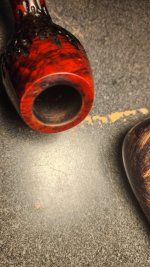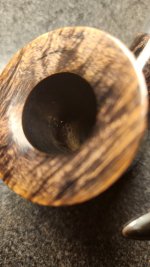Doesn't roughness increase the surface area, helping it to breathe?

Once in a while I read of the of „breathing briar“ or that it will become brittle when it’s getting old.
The breathing thing is just a romantic idea, also the assumption briar could soak up a certain amount of condensation. In both cases the cell structure of Briar is just to dense as in any other hard wood.
There is no way to get any air flow through it. Or any exchange of fluids. If you try to stain briar the alcohol dilution only reaches a fraction of a millimetre into the wood.
What’s true, is that briar as any other wood accommodates to different levels of air humidity, once the cell water and saps of the living briar bowl has been dried out. But the process of taking in humidity takes some time. It’s not a sponge.
What happens when the surface of the inner bowl is rough is presenting slightly more expanse to the glowing ember, maybe slightly more wood gets burned at first light, the smell and taste of burned briar might get more intense. But anyways it’s soon going to build a charcoal coating, that isolates it from the heat.
It’s just a sign of bad craftsmanship, of bad drilling.
And another thing about briar: it’s actually harder than white oak. It’s not going to be brittle or fragile over the times as i read in another thread few days ago. As any other wood it’s getting even harder. In that process it gets stronger but looses some flexibility, so it might break and not bend if strong forces are applied.
Have you ever tried to get a nail into a 100 year old oak beam? You can’t do it.










